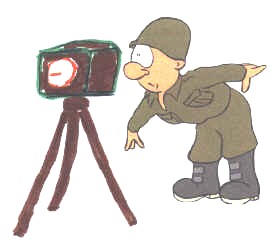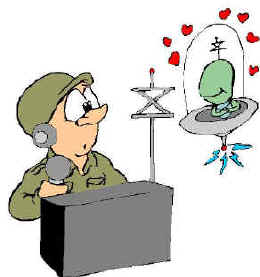Distance Measuring Equipment
| Est modus in rebus(there is a measure in all
things)
Aristotle |
D Vautier
11/2006
When
you run an Army survey the idea is to know your location on the earth, or more accurately, where you are in relation to the rest of
your army, especially the big guns. By knowing this you can tell the artillery pieces and all
other available attack elements which way to shoot, how much to shoot and how far away the enemy is.
This
is a good way to make the those enemy guys very uncomfortable.
 The most easiest method to extend geographic co-ordinates,
or “control” is by traverse. A
survey traverse consist of a series of “legs” of known direction (asmuth)
and distance. By applying trigonometry, it’s easy to calculate the coordinates of the next
point, and then the next, and so on. It is also a good idea to close the traverse on another
known point or on the same point. That
way you can figure your overall accuracy. Closing
on the same point verifies distance but not asmuth (direction).
Closing
on another point does both.
The most easiest method to extend geographic co-ordinates,
or “control” is by traverse. A
survey traverse consist of a series of “legs” of known direction (asmuth)
and distance. By applying trigonometry, it’s easy to calculate the coordinates of the next
point, and then the next, and so on. It is also a good idea to close the traverse on another
known point or on the same point. That
way you can figure your overall accuracy. Closing
on the same point verifies distance but not asmuth (direction).
Closing
on another point does both.
When we were in military training at
Fort Sill, we had little access to good distance measuring equipment. There was no electronic equipment (DMEs) at all so
we got to “chain” distances between stations using a 100 meter steel
tape. The lead chainman ran forward dragging the tape, and when properly lined up
on the forward station, the rear chainman hollered "stick" and the
forward guy would drop his plumb bob, trying not to hit his foot. If
he got a good stick, he would holler "stuck", mark the spot with a
witness pin and drag the tape another 100 meters. If you needed to go over a hill you had to "break tape", a
process to horrible even to describe. After a few hours of this
"stick-stuck" business you tend to go completely insane.
When I first got to Germany, I
discovered to my undying happiness that nobody did the stick-stuck thing at
all (nevertheless people still tended to go completely insane anyway). Instead they used these wonderful DME devices, which were accurate to 4
parts per million, plus or minus 1.5 centimeters, and that sounded pretty
damn fine to most of us (the 1.5 centimeters came from the width of the cathode
because the last crystal couldn’t tell which side of the wave it was
on—thought you'd never ask).
The
DME devices were big boxes crammed with electronics with parabolic domes on
the front of them. They
measured distances by means of wave comparison. There were 6 crystals.
Stations
were designated “master” and “slave” and switched around
after a measurement was completed to reduce error. The
DME
 operator ran through the six crystals; 1000 meter, 100 meter,
10 meter, 1 meter, 1 centimeter, and finally 1 millimeter. He would turn a knob until the needle came to zero.
He was then reading the point where the wave was being returned in the
same phase that it was sent out at. Each reading was recorded and by simple addition, the exact
distance was calculated.
operator ran through the six crystals; 1000 meter, 100 meter,
10 meter, 1 meter, 1 centimeter, and finally 1 millimeter. He would turn a knob until the needle came to zero.
He was then reading the point where the wave was being returned in the
same phase that it was sent out at. Each reading was recorded and by simple addition, the exact
distance was calculated.
Pretty
slick stuff—lots better than “stick stuck” technology for sure. DMEs could measure up to maybe 20 Ks (kilometers) but the recommended
maximum distance was 15 Ks.
I was on my fifth survey or
thereabouts. It was a long one. We
were sitting on a gentle hill overlooking a little German town in the
valley below us. It was about 7 PM. Far
off in the distance over the fog was the spire of a castle. My party chief drove up:
Chief: We’re going to close this survey on that castle.
Me: Sounds good chief. So where is our forward station?
Chief: I just told
you. It’s that castle.
Me: Er, ahh, excuse me
chief, what?
Chief: It’s that
castle.
Me: Er, Ahhh, I hate to
bring this up but we have a few minor problems here, er, chief. That castle looks like its wwwwaaaayyyyy far away, like, 20 Ks or so.
Our DMEs will never work over that distance. And besides how are you going to get line-of-sight to that castle
with all the fog?
Party
chief: We’ll do a night
shot. We’ll wait for the fog
to clear. I’m going over
there now. Sit tight. Stay alert. Talk to you
on the horn.
And that’s all there was to it. Here we were stuck up here on this miserable hill, it was
getting close to nightfall, and we were expected to close this damn survey before
tomorrow morning, and the chief wanted to try a 20 K shot. He's dreaming.
In the distance was this castle shrouded in fog, well over
what our DMEs could do, and besides that, we were supposed to shoot an angle
to it, and record a distance? Fat
chance. Is this fantasyland?
 It was also getting cold, real cold.
We huddled around our ¾ ton truck and took turns in the cab where
there was some heat. I
stretched out on the warm hood to stay warm. It was about 1 AM when I fell asleep on the hood.
At about 3 AM I heard the charming voice of Tucker, a member of our
forward team loud and clear on the radio.
It was also getting cold, real cold.
We huddled around our ¾ ton truck and took turns in the cab where
there was some heat. I
stretched out on the warm hood to stay warm. It was about 1 AM when I fell asleep on the hood.
At about 3 AM I heard the charming voice of Tucker, a member of our
forward team loud and clear on the radio.
“Good morning all you boys and girls. I am now speaking from the castle.
Can you see our glorious light?”
I glanced over to the castle and the
fog was gone, and I saw a light. I grabbed my recorder book and a flashlight.
I said to Bonner. “Shoot it, quick shoot the angle”. He began calling out numbers and I started repeating them back and
recording them. Just after he
was finishing the last reading, the light disappeared in the fog. I carefully checked the angle.
It was within tolerance. We
breathed a huge sigh of relief. We
got our angle.
So now our attention was completely
focused on the DME operator. He
started calling out numbers. The
cold air and night must have helped, because all he got earlier was static.
He was able to get what looked like a good distance. It was just a little over 24 Ks.
He had to do it three times. We
transmitted the information to the guys who did the math. About 2 hours later we got the message.
“Good job. The survey
closed real tight. Come on home” We were all exhausted.
The survey closed better than fine. Thanks to that 24 K leg, it’s accuracy was 1 over 30 thousand.
Our requirement was 1 over 5 thousand for forth order work. Nobody believed that we actually could take a 24 K DME shot, but we
did it.
 The most easiest method to extend geographic co-ordinates,
or “control” is by traverse. A
survey traverse consist of a series of “legs” of known direction (asmuth)
and distance. By applying trigonometry, it’s easy to calculate the coordinates of the next
point, and then the next, and so on. It is also a good idea to close the traverse on another
known point or on the same point. That
way you can figure your overall accuracy. Closing
on the same point verifies distance but not asmuth (direction).
Closing
on another point does both.
The most easiest method to extend geographic co-ordinates,
or “control” is by traverse. A
survey traverse consist of a series of “legs” of known direction (asmuth)
and distance. By applying trigonometry, it’s easy to calculate the coordinates of the next
point, and then the next, and so on. It is also a good idea to close the traverse on another
known point or on the same point. That
way you can figure your overall accuracy. Closing
on the same point verifies distance but not asmuth (direction).
Closing
on another point does both.
 It was also getting cold, real cold.
We huddled around our ¾ ton truck and took turns in the cab where
there was some heat. I
stretched out on the warm hood to stay warm. It was about 1 AM when I fell asleep on the hood.
At about 3 AM I heard the charming voice of Tucker, a member of our
forward team loud and clear on the radio.
It was also getting cold, real cold.
We huddled around our ¾ ton truck and took turns in the cab where
there was some heat. I
stretched out on the warm hood to stay warm. It was about 1 AM when I fell asleep on the hood.
At about 3 AM I heard the charming voice of Tucker, a member of our
forward team loud and clear on the radio.